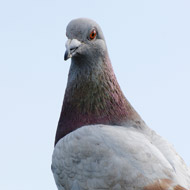Pigeons ‘better at multi-tasking than humans’

Their findings challenge previous assumptions that cognitive ability requires a complex mammalian cerebral cortex.
New research has shown that, despite their small brain size, pigeons are just as good at multi-tasking as humans, if not a little better.
Scientists have long been puzzled by the fact that some birds, such as crows and parrots, can rival chimpanzees in terms of their cognitive ability. Now, researchers from Germany say they have a partial answer; it is because of their small brains, that are densely packed with nerve cells, that birds can reduce the processing time for tasks that require rapid interaction between different groups of neurons.
Their findings have been published in the journal Current Biology.
Biopsychologists used a multi-tasking exercise that was performed by 15 humans and 12 pigeons. All participants had to stop a task in progress and switch to a different task as quickly as possible.
There were two variants in the manner of switching tasks. Either the switchover to the new task was done at the same time as the first task was stopped, or after a delay of 300 milliseconds. In the first case, true multi-tasking takes place; two processes run simultaneously in the brain. Pigeons and humans slow down the same amount under double stress.
In the second case - switching to a new task after a short delay - the brain processes undergo a change. The groups of nerve cells that control both processes have to send signals back and forth continuously. Pigeons were found to be 250 milliseconds faster than humans, which researchers attribute to their greater nerve cell density.
Sara Letzner, from Ruhr-Universität Bochum, explained: “For a long time, scientists used to believe the mammalian cerebral cortex to be the anatomical cause of cognitive ability; it is made up of six cortical layers.”
However, in birds, this structure does not exist. “That means the structure of the mammalian cortex cannot be decisive for complex cognitive functions such as multitasking,” she added.
The pallium in birds does not have any layers that are comparable to those in the human cortex, but the neurons are packed more densely.
Pigeons have six times as many nerve cell signals per cubic millimetre of brain, compared to humans. Therefore, the distance between two neurons is 50 per cent shorter than in humans. Nerve cell signals are transmitted at the same time in birds and humans, leading researchers to conclude that information is processed more quickly in avian brains than in human.
Their findings challenge previous assumptions that cognitive ability requires a complex mammalian cerebral cortex.



 The BSAVA has opened submissions for the BSAVA Clinical Research Abstracts 2026.
The BSAVA has opened submissions for the BSAVA Clinical Research Abstracts 2026.